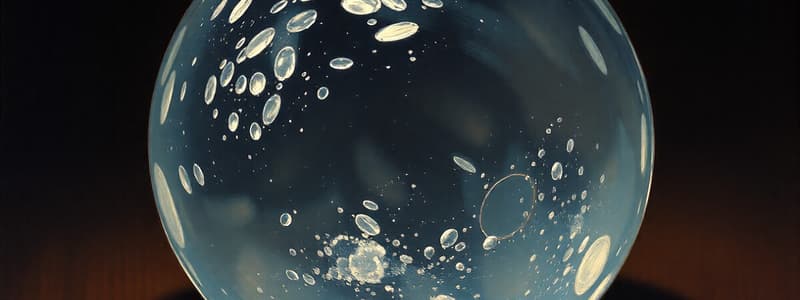Podcast
Questions and Answers
What is a conceptual paper mainly about?
What is a conceptual paper mainly about?
- A marketing strategy for a new product
- A foundational guide to creating researches (correct)
- A detailed personal biography
- A summary of fictional stories
What does the 'Rationale' section of a concept paper explain?
What does the 'Rationale' section of a concept paper explain?
- The detailed methodology used.
- The budget allocation for the project.
- The reason for choosing the topic (correct)
- The historical background of the problem.
What should the 'Objectives' section of a concept paper contain?
What should the 'Objectives' section of a concept paper contain?
- The researcher's personal feelings.
- The estimated word count of the paper.
- The font size and style guide.
- The questions to be answered in the study. (correct)
What do you call the part of the concept paper that discusses the process and materials for the study?
What do you call the part of the concept paper that discusses the process and materials for the study?
What are the 'Expected Outcomes' or 'Results' in a concept paper?
What are the 'Expected Outcomes' or 'Results' in a concept paper?
What is the first step in creating a concept paper?
What is the first step in creating a concept paper?
What activity involves collecting ideas for use in supporting your research?
What activity involves collecting ideas for use in supporting your research?
What should be done to clarify the research plan?
What should be done to clarify the research plan?
What is the length and clarity of the concept paper?
What is the length and clarity of the concept paper?
What are the two qualities that define a concept paper?
What are the two qualities that define a concept paper?
Flashcards
Konseptong Papel
Konseptong Papel
Basic guidelines for creating a research paper and the things to research.
Rasyonal
Rasyonal
States the reasons for choosing the topic, based on personal interest.
Layunin
Layunin
States the requirements to answer in the study
Metodolohiya
Metodolohiya
Signup and view all the flashcards
Inaasahang Bunga o Resulta
Inaasahang Bunga o Resulta
Signup and view all the flashcards
Magplano at Maghinuha
Magplano at Maghinuha
Signup and view all the flashcards
Maghanda at Mangolekta
Maghanda at Mangolekta
Signup and view all the flashcards
Maikli ngunit malinaw
Maikli ngunit malinaw
Signup and view all the flashcards
Makatotohanan
Makatotohanan
Signup and view all the flashcards
Study Notes
The Mole
- The atomic mass of an element is mass of one atom, expressed in atomic mass units (amu).
- $1 \mathrm{amu} = 1.66054 \times 10^{-24} \mathrm{g}$
- The molar mass is the mass of one mole of a substance expressed in grams per mole (g/mol).
- The molar mass of an element is numerically equal to its atomic mass in amu.
- Example: Sodium's atomic mass is 22.99 amu; its molar mass is 22.99 g/mol.
- One mole of any substance contains the same number of particles (Avogadro's number): approximately $6.022 \times 10^{23}$.
- $1 \mathrm{~mol} = 6.022 \times 10^{23} \text{ particles}$
- The mole allows conversion between mass, number of particles, and volume (for gases).
Calculations Involving the Mole
- To find how many moles are in 25.0 g of potassium chromate ($\mathrm{K_2CrO_4}$), divide the given mass by the molar mass (194.2 g/mol)
- Moles of $\mathrm{K_2CrO_4}$= 0.129 mol
- To find how many grams of gold (Au) are in 15.3 moles, multiply the number of moles by the molar mass of Au (196.97 g/mol).
- Grams of Au = 3013.6 g
- To find how many atoms are in 10.0 g of lead (Pb), first find the number of moles by dividing the given mass by the molar mass of Pb (207.2 g/mol).
- Moles of Pb = 0.0483 mol
- Multiply the number of moles by Avogadro's number ($6.022 \times 10^{23} \mathrm{~atoms/mol}$)
- Atoms of Pb = $2.91 \times 10^{22}$ atoms
Chemical Formulas
- The formula mass of a compound is the sum of the atomic masses of all the atoms in its formula.
- The formula mass of water $(\mathrm{H_2O})$ is 18.02 amu.
Percent Composition from Formulas
- The percent composition of a compound is the percentage by mass of each element in the compound.
- $\text{Percent composition of element} = \frac{(\text{number of atoms of element}) \times (\text{atomic mass of element})}{\text{formula mass of compound}} \times 100%$
- In potassium chromate $(\mathrm{K_2CrO_4})$, % K = 40.27%, % Cr = 26.78%, and % O = 32.96%.
Empirical and Molecular Formulas
- The empirical formula is the simplest whole-number ratio of atoms in a compound.
- The molecular formula is the actual number of atoms of each element in a molecule.
Steps for Determining Empirical Formula
- Convert mass percentages to grams, assuming a 100 g sample.
- Convert grams to moles by dividing the mass of each element by its molar mass.
- Find the simplest whole-number ratio by dividing each mole value by the smallest mole value.
- Write the empirical formula using the whole-number ratios as subscripts.
Steps for Determining Molecular Formula
- Calculate the empirical formula mass.
- Calculate the ratio between molecular and empirical formula mass:$\frac{\text{Molecular formula mass}}{\text{Empirical formula mass}} = \text{integer}$
- Multiply the subscripts in the empirical formula by this integer to obtain the molecular formula.
Empirical and Molecular Formula Example
- For a compound with the composition Na: 29.1%, S: 40.5%, O: 30.4%, and a molecular mass of 158 g/mol, the empirical formula is $\mathrm{Na_2S_2O_3}$.
- The molecular formula is the same as the empirical formula: $\mathrm{Na_2S_2O_3}$.
Studying That Suits You
Use AI to generate personalized quizzes and flashcards to suit your learning preferences.



